The rapid expansion of the space industry has been accompanied by a dangerous buildup of orbital debris that threatens the future of human activities in space. We are quickly approaching the point where the debris created by an orbital collision could trigger a cascading chain reaction of collisions that would render the low Earth orbit unnavigable for generations. The future of the space industry depends on immediate mitigation measures to address this crisis. Solving the orbital debris crisis will depend on regulatory and other actions to equip every spacecraft with the propulsive means to avoid collisions, extend its lifetime, and deorbit safely at the end of its mission.

Key Findings
The exponential growth in the number of satellites in space will exacerbate the volume of debris in Low Earth Orbit (LEO).
The growth in the volume of orbital debris is unsustainable and could soon reach a tipping point where the debris created by a collision would start a cascading chain reaction of other collisions, known as the Kessler Syndrome, which would render entire orbits unnavigable for future generations. Stronger regulatory action is needed to create incentives for removing existing debris, as well as ensuring satellites and other spacecraft have the means to avoid collisions, extend lifetimes, and deorbit.
Propulsion systems will be vital to preventing the buildup of debris. However, propulsion systems that rely on pressurized gas as their propellant source pose an explosive risk, which increases with the growth of space clutter and threatens to create dangerous clouds of high-velocity debris. The growth in the volume of orbital debris is unsustainable and could soon reach a tipping point where the debris created by a collision would start a cascading chain reaction of other collisions, known as the Kessler Syndrome, which would render entire orbits unnavigable for future generations.
Ionic liquid electrospray is the safest, most practical, and most promising next-gen alternative to legacy propulsion systems. It is the only technology that incorporates all the important advantages of a propulsion system. It poses minimal explosive risk, supports redundant and resilient design, can be fired near-instantly, is highly power- efficient, compatible with multi-modal propulsion, and can be manufactured at scale. Critically, it is the only technology that scales from smallsats all the way to the largest satellites.
The space economy has accelerated rapidly over the past decade, as commercialization and falling deployment costs have lowered the barriers to entry and unlocked considerable value generation. Thousands of satellites have launched into low Earth orbit in the last five years, with many thousands more to follow in the next five years. But this rapid expansion of space activities threatens to bring about its downfall if we, as an industry, do not take immediate action to make our activities sustainable.

On November 15th, 2021, a Russian anti- satellite (ASAT ) weapon test destroyed a satellite, creating at least 1,500 pieces of trackable debris. This debris threatened other satellites and the lives of the astronauts aboard the International Space Station, who had to lock down for safety.
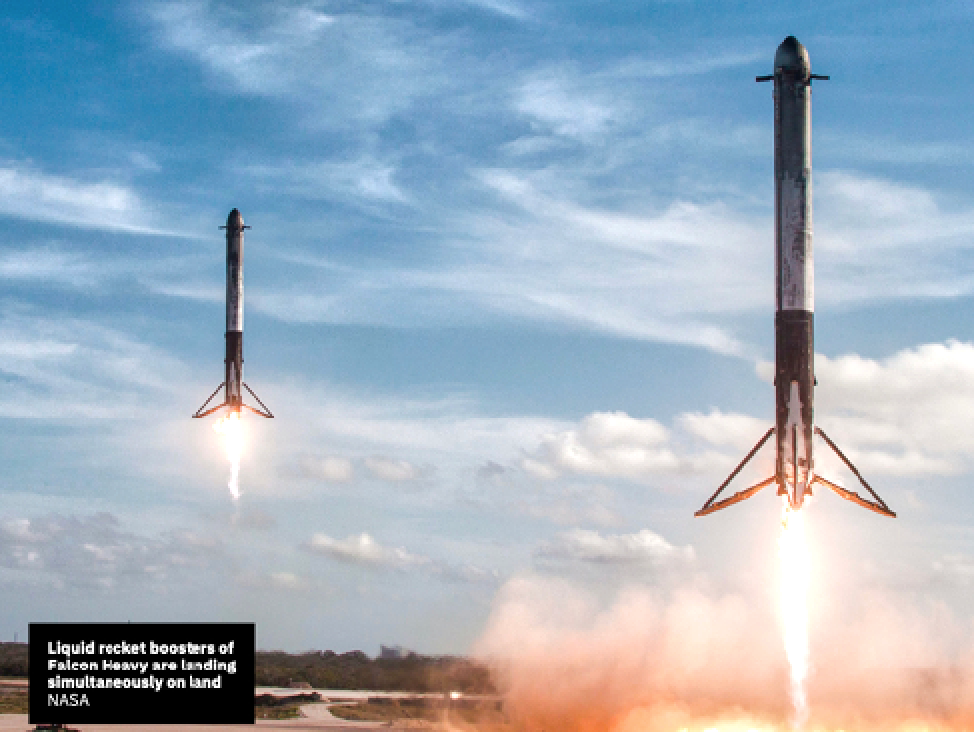
ASAT weapons aside, the risk of debris- generating collisions increases exponentially with the rising number of satellites and other objects in orbit. With over 70,000 new satellites poised to join the Earth’s orbit soon, we are rapidly approaching the point where a single collision would trigger a cascading chain reaction of debris collisions, and that would render the LEO unnavigable for generations to come. The future of the space economy and all it entails — tourism, asteroid mining, Earth Observation (EO), interplanetary colonization, and more – depends on preventing the build-up of debris at all costs and as soon as possible. Safety and sustainability in space require innovative solutions to equip satellites with the means to evade debris and avoid becoming debris themselves. Specifically, satellites need propulsion to maneuver away from collisions, extend their mission lifetimes, and remove themselves from orbit at the end of their mission. Needless to say, this next generation of propulsion systems should not in itself increase the risk of debris build-up.
It is time for the industry to move beyond the propulsion systems pioneered in the last century, whose reliance on pressurized gas creates an unsustainable explosive risk, which would dramatically increase the quantity and velocity of debris in an in-space collision. The next generation of propulsion systems, including technologies such as ionic liquid electrospray, are safer, more efficient, and scalable to the needs of the expanding space economy.
A Sustainable Future In Space: The Challenges
Achieving a sustainable future in space is a multifaceted challenge, requiring a strategy to overcome a variety of critical regulatory and technological hurdles. In this section, we discuss the growing safety and sustainability concerns associated with the burgeoning space economy, the unmanageable proliferation of space objects, and the risks associated with volatile satellites already in space.
The Growth of the Space Economy
The launch of Sputnik, humankind’s first satellite, in 1957 marked the dawn of a new era for the people of the ‘Pale Blue Dot’’. Seven decades and more than 11,000 satellites later, the rapidly growing space economy is expected to reach $1 trillion by 2040, according to Morgan Stanley.
Satellites power our modern economy. They provide navigation signals for billions of devices around the globe. They monitor our environment, ships, and planes in ways that can only be done from space. They provide connectivity to remote places, including rural areas that have never before been connected to the internet.
The following data points underscore the importance of a safe environment for LEO satellites and highlight some impending threats:
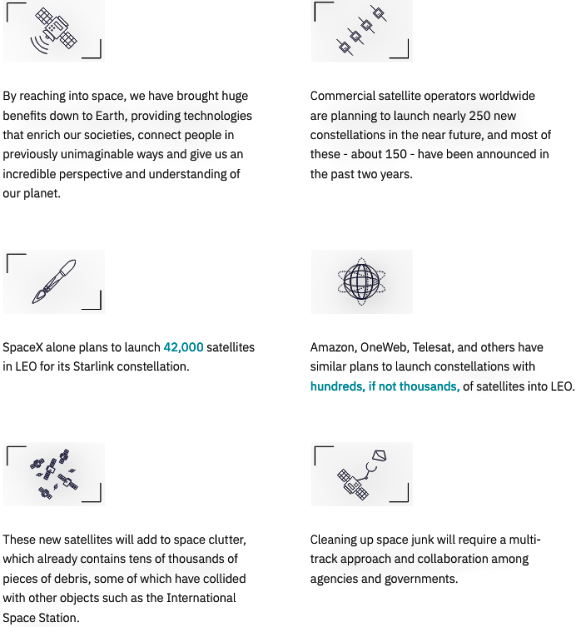
Unsustainable Growth Of Space Objects
Despite the tremendous benefits provided by expanding satellite services, the remarkable growth of the space industry has a dark side. The rapidly increasing number of objects in orbit has created a growing debris problem, which is now approaching a critical level, threatening to become a tragedy of the commons. Estimates suggest that close to one million objects larger than 1 cm. travel at 27,000 km per hour in Earth’s orbit, including satellites, rocket bodies, mission-related ‘junk’ (covers, caps, adapters, etc.), and fragments.
Any one of these objects poses a risk to satellites and spacecraft, including those with humans on board. If that’s not daunting enough, “over 70,000 more satellites could soon enter orbit,” further adding to the clutter. (Source: McKinsey, 2021). The U.S. Space Force is tracking almost 40,000 objects (including 5,000 active satellites) in LEO (as of January 2022) — a 22% increase in two years and a result of new mega-constellations and debris generating events. This number includes only objects that can be tracked from Earth. NASA estimates there are half a million pieces of debris the size of a marble or larger that could still cause significant damage.
And it is only getting worse: As per a recent McKinsey report on commercial satellite constellations, interest in commercial space ventures is growing explosively, with investment increasing more than tenfold this past decade compared to the prior one.
The implications of a collision with any of this space debris could be catastrophic, leading to one of the following outcomes:
• Additional debris would severely handicap the Department of Defense’s intelligence gathering and communication capabilities in space as well as endanger the lives of astronauts on the International Space Station (ISS).
• Any collision will generate new orbital debris, and with it, a higher probability for future collisions.
• Depending on the severity of the resulting debris problem, critical in-space infrastructure, including ISS, would be vulnerable to damage or destruction, or in a worst-case scenario, LEO itself could become inoperable for all future spacecraft (e.g., Kessler syndrome).
• Some of these objects are potentially explosive, leading to further risk of a catastrophe. Additional debris would severely handicap the Department of Defense’s intelligence gathering and communication capabilities in space as well as endanger the lives of astronauts on the International Space Station (ISS)
Creating A Sustainable + Safe Space Future
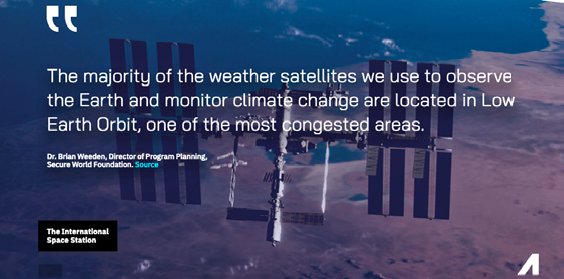
The time is now for us all to do a better job at safeguarding Earth’s orbits and ensure we can use them sustainably and safely for this and future generations. We need to aim to minimize and prevent, where possible, any new debris created as a result of human missions. Governments need to work with civil authorities, commercial partners, and rival regimes to substantially reduce the creation of new debris.
This critical time calls for new collaborations in transparency between operators. We must continue to work together to speed up the development of technologies and practices that dispose of end-of-life spacecraft and existing orbit debris. This includes phasing out propulsion systems using pressurized gasses as propellants, which are highly combustible and risk creating large clouds of debris.
Societal Response
The following societal and governmental efforts have been initiated to address the orbital debris crisis:
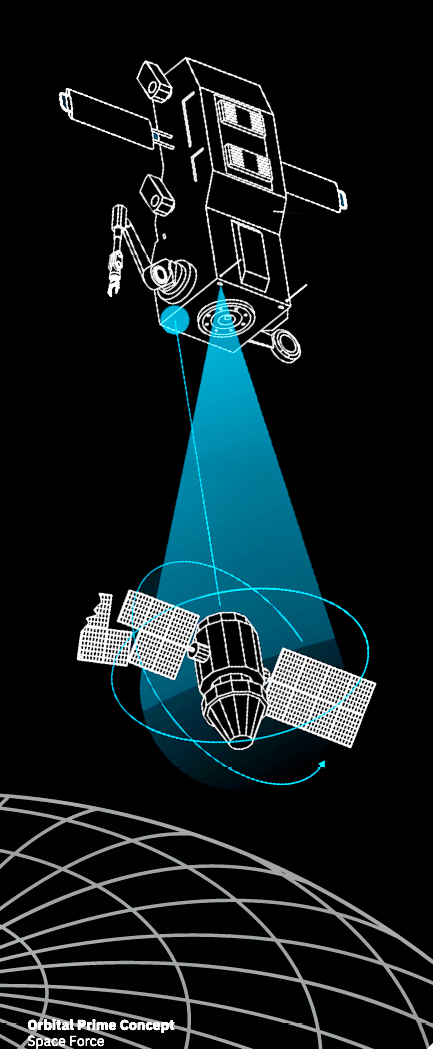
US Government Efforts
An interagency group within the National Science and Technology Council (NSTC) is updating an orbital debris R&D plan to be released in 2022. The Space Force has launched a new project called Orbital Prime aimed at actively removing existing debris from space and potentially recycling it for on-orbit manufacturing and satellite servicing. The report from the House Committee on Armed Services on the National Defense Authorization Act for Fiscal Year 2022 directs the Secretary of Defense to submit a report on the Department’s efforts to reduce future space debris.
“The committee is interested in better understanding defense investments in technologies that may reduce future space debris, including alternatives to pressurized propellant tanks.
“The committee recognizes the importance of the Space Development Agency’s efforts to deliver space-based capability to the joint force by harnessing commercial development to achieve a proliferated and resilient architecture.”
The report included, at a minimum, the following:
• The degree to which the Department of Defense has assessed the impact of space debris on the National Defense Space Architecture
• An assessment of the risk posed by the proliferation of commercial or military satellites in Low Earth Orbit
• The extent to which the Department of Defense is engaging allies and partners on efforts to develop technologies that reduce space debris
• The identification of specific defense research and development efforts to minimize future debris-creating events, including alterna- tives to traditional propellant propulsion systems.
International Efforts
The Inter-Agency Space Debris Coordination Committee has been established to “exchange information on space debris research activities between member space agencies, to facilitate opportunities for cooperation in space debris research, to review the progress of ongoing cooperative activities, and to identify debris mitigation options.”
A Space Industry Debris Statement, formulated at the World Economic Forum 2021, ensures that no actions are taken that purposefully create space debris. “We commit to working with governments, civil society, commercial partners, and competitors to substantially reduce any new debris creation,” the statement reads. “We also call for new collaborations in transparency between operators. Finally, we must continue to work together to speed up the development of technologies and practices for the disposal of spacecraft at end-of-life, and for removing existing debris already in orbit.”

The world’s first space sustainability rating has also been introduced at the World Economic Forum’s Global Future Council on Space to “reduce the risk of collisions and debris generation as well as help ensure that missions launched into Earth orbit are sustainable.”
The rating features four levels of certification that will be given to spacecraft operators, launch service providers, and satellite manufacturers to score and ascertain their mission’s level of sustainability.
The European Space Agency (ESA) is developing technologies for an automated collision avoidance system as well as methods for refueling, repairing, and upgrading satellites in orbit, extending mission lifetimes, and potentially reducing the number of new satellite launches.
ESA is also working on debris removal missions that will fly up to dead spacecraft and debris objects, capture them and move them to safety – either by sending them down to burn up in Earth’s atmosphere or up into ‘graveyard orbits.’
Industry Efforts
At least ten companies and organizations from across the space industry have vowed to devise concrete measures to reduce the amount of in-orbit debris by 2030.
Japan’s solid-fuel Epsilon 5 rocket successfully put nine smallsats into orbit, including a debris removal technology demonstrator; other companies have also been pursuing debris-removing demonstrations.
Astroscale partnered with the government of New Zealand on space sustainability projects.
Technology Response: Safe Alternatives to Traditional Propulsion Systems
Although it will likely be necessary to remove or recycle existing orbital debris, the best way to address the problem is to prevent the creation of debris in the first place. This is especially critical in light of the high number of “pressurized” satellites already in space. As such, alternative methods of propulsion are needed to defuse the already volatile space environment, specifically non-pressurized systems that pose a minimal risk of explosions.
To ensure a sustainable future in space, the Federal Communications Commission (FCC) proposes that every new satellite should be mandated to carry an onboard propulsion system or other means of collision avoidance and deorbiting. The needs of small satellites — the majority of satellites launched in the last decade — must be particularly taken into consideration here.
A thruster can substantially increase the mass of a smallsat and crowd out other mission payloads. For propulsion to be commercially viable for smallsats, thrusters will need small form factors, long service life, high specific impulse and, most importantly, highly efficient, thrust-to-power ratios.
There are two viable options for large and small satellites
Field-Emission Electric Propulsion (FEEP) and Ionic Liquid Electrospray.
Hall Effect and Gridded Ion options are only viable for larger satellites and typically contain high-pressure vessels.
The table at right compares the various propulsion technologies.

Ionic Liquid Electrospray
Accion TILE
As is apparent from the table on the previous page, the Ionic Liquid Electrospray (e.g., Accion TILE) technology displays key advantages over alternative propulsion options, summarized below:
• The use of ionic liquid propellant in a low-pressure tank (0-1 atmospheres or 14.7 psi). For reference, this is similar to the air pressure in a typical party balloon.
• Ionic Liquid Electrospray has been approved to be handled safely aboard the International Space Station.
• Flight heritage: this technology has been successfully demonstrated in space during the NASA Tipping Point mission.
• Ionic Liquid Electrospray features an inherently resilient design in that its many chips create natural redundancy, eliminating single points of failure.
• Near-instant thrust: Without long warm- up periods, Ionic Liquid Electrospray can rapidly fire to maneuver satellites out of the path of an imminent collision.
• Compatible with multi-modal propulsion: Ionic liquid can also be used to provide the high thrust of a chemical propulsion system for rapid evasive maneuvers.
• Mass-producible: Due to its inherent simplicity, Ionic Liquid Elec- trospray solutions can be manufactured at scale, providing a timely response to the pressing need to equip the huge quantity of diverse satellites that will be launched in the near future.
• Low interference: Virtually no heat, infrared, RF or visible emis- sions ensure very low interference with sensors, payloads, or other spacecraft.
• Most importantly for collision avoidance maneuvers: Ionic Liquid Electrospray like Accion TILE is uniquely scalable. It provides the best thrust-to-volume, thrust-to-weight, and thrust-to- power ratios among all next-gen propulsion systems. As such, Ionic Liquid Electrospray is ideal for smaller satellites, while scaling all the way up to the largest satellites
Arriving At A Sustainable Space Future
The space economy has tremendous potential to reshape the relationship between our world and the universe around it. However, our current trajectory is unsustainable.
If we do not take the threat of space debris seriously and unify around finding solutions, our future activities in space will be in jeopardy. This includes both the economic gains made from satellite connectivity and EO as well as the national security granted to us by America’s defense infrastructure in space.
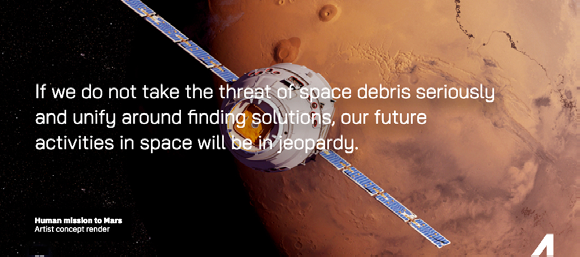
Even capabilities we take for granted, such as weather forecasting and GPS, are now threatened by space debris. The ballooning numbers on the magnitude of the debris crisis are a sobering wake-up call that demands immediate action.
To tackle the crisis, regulatory action is being taken at both national and international levels to ensure that satellites have the propulsive means to avoid collisions, extend their lifetimes, and deorbit at the end of their missions.
However, the explosive risk of the propulsion systems in use must be taken into consideration and minimized whenever possible.
Safer next-gen propulsion systems are gaining more flight heritage and are becoming increasingly efficient and powerful. These next-gen systems work on satellites of all sizes, including the small ones that have thus far democratized access to space and catalyzed the boom in its economic activity.
In particular, Ionic Liquid Electrospray has the potential to be mass-produced at scale to prevent bottlenecks in the deployment of new satellites, especially if propulsion capabilities are mandated for all future spacecraft.
The space industry is by definition one of the most innovative industries the world has ever known. We have the track record and the technology to solve this crisis.
However, the industry must recognize the importance of responsible space operations to ensure the long-term sustainability of the space environment, guaranteeing that space remains viable for future satellites, systems, and the many services that those systems provide to the public.
This article has hopefully provided some practical steps satellite makers can take to bring the world to a more sustainable space future.
If you want to get involved in a safer future for space, contact us to learn about sustainable TILE solutions.


